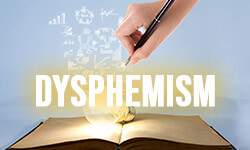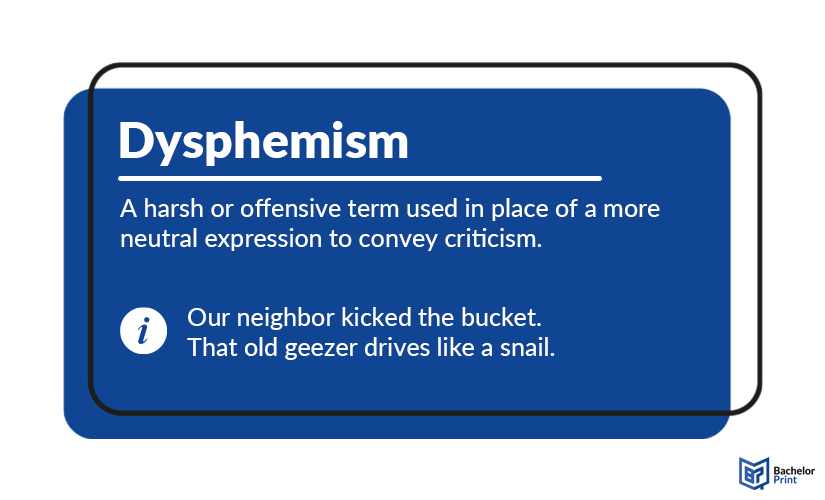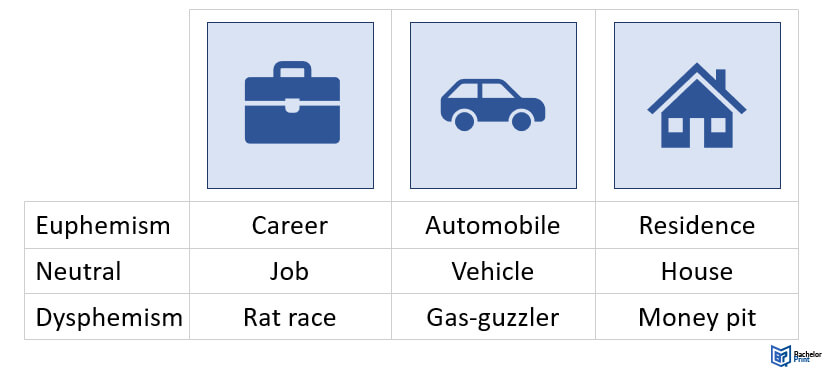
Figures of speech are creative expressions used to enhance the clarity, vividness, or emotional impact of language. By deviating from literal language, they add color and depth to communication, ranging from metaphors and similes to hyperbole and irony. One less-known but impactful figure of speech is dysphemism, known for its deliberate use of harsh or offensive language. This article will shed light on its definition, types, and its use in academic writing.
Definition: Dysphemism
A Dysphemism (also known as Cacophemism) is a figure of speech that involves using a blunt, derogatory, or negative word or phrase instead of a more neutral or polite alternative. It is often used to express criticism, disdain, or a negative opinion and can convey a strong emotional tone in communication.
It contrasts with euphemistic expressions, which are the milder and more indirect opposite used for something unpleasant or offensive. It is a stylistic device employed to express criticism, disdain, or a negative viewpoint and may be motivated by hatred, contempt, fear, or humor and expresses a speaker’s view about a particular topic or person.

Examples
The following examples demonstrate the use of more negative, harsh, or offensive language in place of neutral or polite alternatives:
This example shows how changing “estate tax” to “death tax” in conversations can make the tax seem more negative and unfair. It’s a way to shift options using just words.
This highlights how using terms like “cops” or “pigs” for police officers can be considered disrespectful and carry negative connotations. Using words like “law enforcement” or “officers” is more formal.
This example points out how using derogatory terms like “crazy” or “nutcase” instead of more accurate and respectful terms like “mentally ill.”
Etymology
The term “dysphemism” is derived from the Greek language and functions as a noun in the English language. It is formed by combining two Greek components:
- “Dys-”: This Greek prefix means “bad,” “abnormal,” or “difficult.”
- “-pheme”: This Greek suffix means “speech,” “voice,” or “reputation.”
When these elements are combined, “dysphemism” is created, which essentially means “bad speech” or “speaking in a negative or harsh manner.” This etymology aligns with the concept of the term itself, which involves using harsh or negative language to convey a message.
From euphemism to dysphemism
The process of pejoration might affect words that were once euphemisms but changed into dysphemisms over time. The transition is a fascinating aspect of language that reveals much about social attitudes and communication styles.
Euphemisms involve the use of mild, less direct, or vague language to replace words and phrases that might be considered harsh or offensive. It is often used to soften the impact of what’s being said, making it more palatable or socially acceptable. For instance, saying “passed away” instead of “died” is a common euphemism.
Dysphemism is usually employed to break social norms. It involves using a blunt, harsh, or more direct term instead of a neutral or softer one. This is typically done to shock, express strong emotions, or even to be humorous. An example would be saying “kicked the butt” in place of “died.”

This shift from euphemism to its counterpart can reflect changes in social norms, cultural attitudes, or personal perspectives. This can also be situational, where the appropriateness of either depends on the context, the audience, and the intent of the speaker. It comes in various forms, and each one has a specific purpose in communicating. Below, you’ll find the different types along with some sample sentences:
Types
This stylistic device comes in various types and forms, each serving a specific purpose in communication. Below, you’ll find the common types along with examples.
Offensive dysphemism
This form, as the name already reveals, uses language that is insulting or offensive and is often employed to shock or provoke the listener.
Referring to someone as a “jerk” or “idiot” instead of a more neutral term like “person.”
Slang dysphemism
This type of dysphemism involves the use of informal or colloquial language that may be considered inappropriate or unrefined in certain contexts. It often appears in casual conversation among specific groups.
Referring to someone as a “dude” in a formal or professional context.
Taboo dysphemism
As the name already implies, it relies on taboo terms or phrases that are socially or culturally taboo. These often pertain to sensitive topics like sexuality, bodily functions, or death.
Referring to a bodily function with a crude term like “taking a dump” instead of using a more neutral expression like “using the restroom” would be considered a taboo dysphemism.
Derogatory dysphemism
This particular form of expression is specifically intended to diminish or demean the subject. It often reflects negative stereotypes or prejudices.
In this context, “perfume” is the neutral term for a fragranced product designed to be pleasant, while “stink bomb” is a dysphemistic expression that humorously suggests the perfume is overwhelmingly unpleasant.
Humorous dysphemism
Oftentimes, this form is used in a lighter, often comedic context, where the negative connotation is employed for humor rather than to offend or insult.
Calling an old and unreliable car a “rust bucket” instead of merely a “used car” is a quite dysphemistic but although humorous expression.
Euphemistic dysphemism
This type represents a unique blend where the term is a euphemism (“good” so to say) in one context but acts as a dysphemism in another, typically depending on the audience’s perspective or cultural background.
In some casual social circles, the term “senior citizen” is used as a euphemism to politely refer to elderly individuals. However, in certain contexts, this term can be viewed with a negative connotation because it indirectly highlights an individual’s age, potentially making them feel older than they actually are or than they are comfortable with. While intended to be polite, it can inadvertently emphasize age and may not always be well-received by everyone.
Synecdoche dysphemism
While synecdoche is a distinct figure of speech, it can be used in a dysphemistic manner. In this case, a part of something is used to represent the whole in a derogatory or negative way.
Referring to a group of people as “suits” to emphasize their focus on business and formality can be considered a synecdoche dysphemism. Here, the term “suits” (representing formal attire) is used to belittle or stereotype individuals, with a negative connotation.
Cross-cultural dysphemism
This specific type occurs when a word or phrase that is neutral or even positive in one culture is considered offensive or negative in another culture. This phenomenon is often due to differences in cultural values, norms, or historical contexts.
In some parts of Europe, the term “gypsy” has been historically used as a cross-cultural dysphemism for the Romani people. This term is considered offensive because it stereotypes and marginalizes this ethnic group, perpetuating negative biases and misunderstandings. Instead of “gypsy,” it is more respectful to refer to them as Romani or Roma people.
Name dysphemism
This kind involves using derogatory or disrespectful nicknames or terms to refer to individuals or groups. It often reflects a negative attitude or bias toward the named entity.
Calling someone a “mop-pusher,” instead of a neutral term like “janitor” or “custodian” is considered as appropriate and disrespectful, and should be therefore, avoided.
Use in academic writing
Clarity and conciseness are crucial in academic writing. The use of dysphemism in academic writing is generally discouraged because academic papers, such as dissertations, research papers, or theses are expected to be objective, clear, and respectful. Academic writing often values precision in language and a focus on conveying information without bias or emotional overtones. Dysphemistic language tends to be very blunt, derogatory, or offensive and can undermine the professionalism and neutrality that are expected in academic texts.
Printing Your Thesis With BachelorPrint
- High-quality bindings with customizable embossing
- 3D live preview to check your work before ordering
- Free express delivery
Configure your binding now!
FAQs
An example of dysphemism is using the term “kicked the bucket” to refer to someone who has died, instead of the more neutral or euphemistic phrase “passed away.”
“Kicked the bucket” is blunt and might be considered as disrespectful or impolite.
Dysphemism and Euphemism are opposite linguistic devices. The former involves using milder or more indirect language to replace phrases that might be considered as unpleasant. However, the latter is using more negative and harsh language in place of neutral or polite alternatives.
Common synonyms for this stylistic device are “derogatory language” or “pejorative expression.”
It is generally discouraged to include dysphemisms in academic writing because academic discourse values objectivity, clarity, and respect. Academic writing is expected to be neutral, formal, and devoid of offensive language.